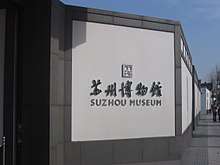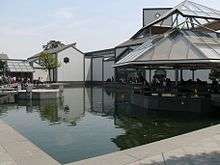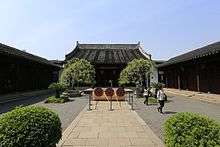Suzhou Museum
The Suzhou Museum (Chinese: 蘇州博物館; pinyin: Sūzhōu Bówùguǎn) is a museum of ancient Chinese art, ancient Chinese paintings, calligraphy, and handmade crafts, situated in Suzhou, Jiangsu, China. Admission is free. It received 1,901,000 visitors in 2016.[1] The Folk Branch of Suzhou Museum is located in the Bei family ancestral temple near Lion Grove Garden.





History
- 1960: Museum founded and first open to the public in the former residence of the Zhong Prince of the Taiping Heavenly Kingdom.
- 2006: The current building designed by Chinese-American architect Ieoh Ming Pei inaugurated.
- Suzhou Folk Museum started to open in 1986 when that year is exactly the 2500th anniversary of Suzhou city's establishment and it is one of National Key Culture Relics Protection Units now.
Current building
The current building of Suzhou Museum was designed by Pritzker Prize-winning Chinese-American architect I.M. Pei in association with Pei Partnership Architects. The structural engineer for this project was Leslie E. Robertson Associates. Construction of this building started in 2002. It was inaugurated on October 6, 2006.
The multi-year process of designing, building and inaugurating the new museum was chronicled in PBS's American Masters television documentary series in a 2010 episode entitled "I.M. Pei: Building China Modern".[2]
Collections
The museum has a display area of 2,200 square meters. It has more than 15,000 pieces in its collections. Most are ancient paintings and calligraphy, ceramics, crafts, unearthed relics and revolution relics. It also possesses more than 70,000 books and documents, and over 20,000 rubbings of stone inscriptions. The collection of paintings and calligraphy includes works of masters from Song Dynasty to Ming and Qing dynasties.
District
The display part the Folk Brunch of Suzhou Museum falls into three districts, which is composed of Local Festival Hall, Lucky Traditions Hall and Children Rearing Hall.
Local Festival Hall
It took quite a long time for the forming and development of local festival, while traditional festivals in our country came into being and developed along with agricultural civilization. Suzhou is a land flowing with milk and money with wild climate and distinctive four seasons and it has developed rice agriculture and abundant water resources. Therefore, festivals and cultural traditions in Suzhou are characterized water and unique local flavor. The key displays include: Sightseeing in Shangtang, Roll the immortal, The Dragon Boat Festival, Mid-autumn Day, Appreciating Lotus Festival, Kitchen Models and Dragon and Phoenix lanterns.
Lucky Traditions Hall
Lucky traditions reflect people's ideas of avoiding bad omen and wishing good luck and longing for longevity and happiness. Traditions in Suzhou are extremely colorful and wonderful and reflect in all aspects such as faith, etiquette and production and living, representing Suzhou people's good yearning and pursuits. The key displays include: Worship Valiant General, Twelve Months Flowers'Goddess, Marriage God, Burning Incense in Dongyue Temple and good fortune, official pay and longevity.
Children Rearing Hall
Suzhou has different kinds of children rearing traditions since a long time ago. A series of rituals and affairs need to be finished at one's birth, full-month and first-year, which are important components of local traditions, reflecting expectations on offspring from family and society. This series of displays relatively focus on characteristics of children rearing traditions in Suzhou in past times. Not only did it shoe our country's tradition of emphasizing on human relations, it also reflected people in Suzhou attached great importance on culture and education. The key displays include: Full Month Birth, Baby Draw Lots, Seeking Godparent, and Uncle Sending to the school and Weighing People in Summer Begins.
Design
The new Suzhou Museum is said to be the last design of Mr. I.M.Pei in his career. Therefore, not only does it become a monumental design building in Suzhou, but also a significant construction, merging the traditional Chinese architectural design with the future.
The design of the new museum house combines traditional Suzhou architectural style and places the museum between the courtyards to harmonize the building with its surrounding environment. The museum's central courtyard is an extension of the northern garden's architectural style and a modern interpretation. New museum courtyards, smaller exhibition areas, and administrative areas of the yard in the landscaping design get rid of the traditional landscape design ideas.[3]
The new design idea is to find a new direction and theme for each garden and to extract the essence of conventional landscape design and form the future development direction of Chinese garden architecture. While white powder walls will be the leading tone of the new museum building to blend the building with the traditional urban mechanics of Suzhou, the ubiquitous, stereotypical grey tile slopings and window frames will be replaced by grey granite in the pursuit of better uniform colors and textures.[3]
The design of the roof of the museum is inspired by the traditional sloping roof landscape of Suzhou. However, the new roof has been reinterpreted and evolved into a new geometric effect. The glass and stone roof construction system is derived from the traditional roof system, and the old wooden beam and rafters frame system will be replaced by the modern open steel structure, wood and paint ceiling system. Metal sunshades and nostalgic woodwork frames will be widely used under glass roofs to control and filter the sun's rays entering the exhibition area. Its architecture and innovative horticulture depend on each other.[3]
Pei designed the central courtyard and several small inner courtyards in an exquisite layout. Among them, the unique is the northern courtyard on the central axis, which not only enables visitors to see the features of Jiangnan waterscape through the lobby glass, but also connects the garden directly with the garden of humble administrator's yard across the north wall, and integrates the old and new landscape. The central courtyard, north of the central hall, is said to be the most elaborate. The main yard is surrounded by the building on the east, south and west sides, and is adjacent to the Zhuozheng garden on the north. This is a creative landscape garden elaborately created from classical garden elements. It is composed of pebbled ponds, rocky rockery, straight winding Bridges, octagonal pavilion and bamboo forest. It is different from traditional Suzhou gardens, but not separate from the Chinese cultural atmosphere and charm.[3]
The water view starts from the northwest corner of the north wall, as if from the west of the garden. the original stone rockery is under the north wall. When asked why the traditional Lake Taihu stone was not adopted, Pei once said that the conventional rockery art has been unable to surpass. The master of innovation for the whole life, does not wish to follow the footsteps of predecessors. This kind of "paper by the wall, painting by the stone," unique landscape, presents a clear outline and silhouette effect. It makes people look as if they are connected with the humble administrator's garden nearby.[3][4]
If the vestibule is the prelude of the whole space, so after entering interior only, we can discover the starting place of whole space. Mr. Pei changed the usual square space and designed the atrium into the octagon. At the same time, he changed the wall shape as the height increased, reflecting the architectural features of the scattered Jiangnan slope roof. Among them, triangle and rhombic are the main modeling elements; the gray paint emphasizes the transition of each form, forming a rich, rhythmic space effect. At the same time, due to the variable shape, the sunlight coming through the overhead window forms an interesting and subtle shadow effect, which emphasizes the drama of space.[3]
Just opposite the entrance is a sheet of floor-to-ceiling glass with views of the landscape outside. On both sides of the wall, there are two rhombic window holes; transmission is still an outdoor green landscape like two paintings hung on the wall. It is not hard to find that simple geometric shapes are the language of the designer to shape the space. However, these modern design elements create a space temperament full of traditional taste through interpenetration and combination. The drop light of atrium also is designed independently, take its form of traditional Chinese style lantern, reuse square and lozenge structure to combine traditional spirit perfectly with modern material and become.[3]
Architectural style and form have strong "Su, China, and New" characteristics. "Su" is mainly reflected in the integration of Suzhou's ancient city features and cultural connotation. "New" mainly manifests in the material. With his wisdom and unique design style, master Pei made "new" full of "Su flavor" and became "Su" and "China" of innovation.[3]
The design of the roof of the new museum is inspired by Suzhou's traditional slope-top landscape -- cornices and meticulous architectural details. However, the new roof has been reinterpreted by technology and evolved into a fantastic geometric effect. The glass roof will set off against the stone roof, allowing natural light to enter the event area and the exhibition area of the museum, providing visitors with guidance. Metal sunshades and nostalgic woodwork frames will be widely used under glass roofs to control and filter the sun's rays entering the exhibition area. The level change of light, let a person enter a poem into a picture, wonderful. Pei always said that using light to design.[3][4]
Form processing
Several octagonal halls and the main geometric roof cut solve not only the roof lighting problem, but also reduce the volume, full of wisdom, interest, and ingenuity. The design USES triangle (diamond) as the parent element of the inside and outside modeling repeatedly, whether it is the block cutting, the facade opening window and the steel roof truss structure, skylight, are used appropriately. The frame line of housetop is formed by size square and triangle, the glass inside the frame and white smallpox are staggered each other, resemble a geometrical form illusion to paint, give a person with wonderful and unified vision concussion, leave a deep impression. The new hall and the humble administrator's garden will complement and reflect each other. It will be a continuation of the modernization of the humble administrator's garden.[3][4]
Contrast between tradition and modernity
On the use of building materials, "China black" granite slabs to replace brick tiles, cut into rhombic body block, hung in stainless steel plate made of slope roof, black with gray "China black," rain is black, the sun becomes dark gray. The roofing of dark gray stone material and wall side are decorated, match with a white wall, and become an integral whole with the wall body. The unique combination of tradition and modern innovation adds a new interpretation to the Jiangnan architectural symbol of white walls and black tiles. The architectural colors are traditionally black, white and gray in Suzhou. It is worth mentioning that the interior design of the building includes every display cabinet and display layout design, which is carefully designed by the architect and forms a unified whole with the interior and exterior space of the building. Its interior part top lumber board makings, the shop of ground, and wall body processing, concise and easy and harmonious and unified with building basic design, guileless. On the top of the hall, walkway, roof steel frame, glass roof and the high window of the exhibition hall, the wide application of wood grain metal sunshades makes the museum full of warm and soft sunlight.[3][4]
Structural characteristics
Due to the need of building function, the basement is too long, and multiple measures are adopted in the structural design to prevent concrete shrinkage cracks. The structure system is concrete shear wall structure, which not only has good seismic performance, but also coordinates well with the building function, so it is convenient for the museum to be displayed. The structure also adopted the new steel structure truss as a roof structure. Using steel structure instead of Suzhou traditional architecture in modern wooden material not only conforms to architectural modeling, and embodies the aesthetic of modern architecture, realizes the "Su and new" design concept, "embroider" give a "traditional Suzhou" and "modern Suzhou" fusion "double-sided embroidery."[3][4]
See also
References
- "TEA-AECOM 2016 Theme Index and Museum Index: The Global Attractions Attendance Report" (PDF). Themed Entertainment Association. pp. 68–73. Retrieved 23 March 2018.
- "I.M. Pei: Building China Modern". PBS. Retrieved 2 August 2012.
- "贝聿铭与苏州博物馆设计 | 后时代". houshidai.com (in Chinese). Retrieved 2018-11-16.
- "SUZHOU MUSEUM". www.szmuseum.com. Retrieved 2018-11-16.
External links
| Wikimedia Commons has media related to Suzhou Museum. |